Exciting Wildlife Discovery at Mt. Gibson
In a thrilling breakthrough for wildlife conservation, ecologists at Mt. Gibson Wildlife Sanctuary in Australia have made an extraordinary discovery: the first-ever baby western quolls were born at the sanctuary. Researchers spotted several female quolls carrying tiny, wriggling infants in their pouches during a routine survey.
The Fascinating Western Quoll
Western quolls, also known as chuditch, are marsupials roughly the size of domestic cats. These fascinating creatures play a vital role in their ecosystems, helping control populations of small invertebrates, reptiles, and birds. However, their numbers have dwindled in recent years. According to the Australian Wildlife Conservancy (AWC), their once vast range has been reduced significantly since European settlement.
A Promising Sign for Conservation Efforts
Today, western quolls are mostly found in southwestern Western Australia, but their distribution remains patchy. Due to habitat loss and human activity, conservationists have worked hard to reintroduce these animals into their former habitats. The recent births are a hopeful indication that these efforts are beginning to bear fruit.
“It’s heartening to see the quolls thriving after reintroduction,” said Georgina Anderson, senior field ecologist at AWC. “The successful adaptation to their new environment and the sighting of pouch young is a major achievement for the sanctuary.”

The baby western quolls huddled together in a box filled with straw bedding, Photo Credit: Australian Wildlife Conservancy/Facebook
Expanding the Quoll Population
Conservationists are also transporting groups of quolls across the country to establish sustainable, diverse populations. This month’s transfer marks another key step in ensuring these marsupials not only survive but thrive in the wild.
“We’re thrilled to see the western quoll population flourishing at Mt. Gibson,” Anderson added. “These signs of successful breeding offer optimism for the species’ future.”
Restoring Australia’s Ecosystems
The reintroduction of the western quoll is part of a broader plan to restore Australia’s unique ecosystems. Conservationists hope these efforts will help the quolls reclaim more of their lost habitats.
A Beacon of Hope
With the growing urgency surrounding habitat destruction and climate change, the birth of these baby quolls offers a hopeful message. It underscores the importance of conservation efforts and demonstrates that, with the right intervention, recovery is possible.
For wildlife enthusiasts, this news highlights the critical role of community involvement in conservation. Whether through volunteering, donations, or spreading awareness, everyone can contribute to securing a better future for Australia’s native species. The birth of these quoll infants at Mt. Gibson shows the power of nature’s resilience and the positive effects of human intervention.





